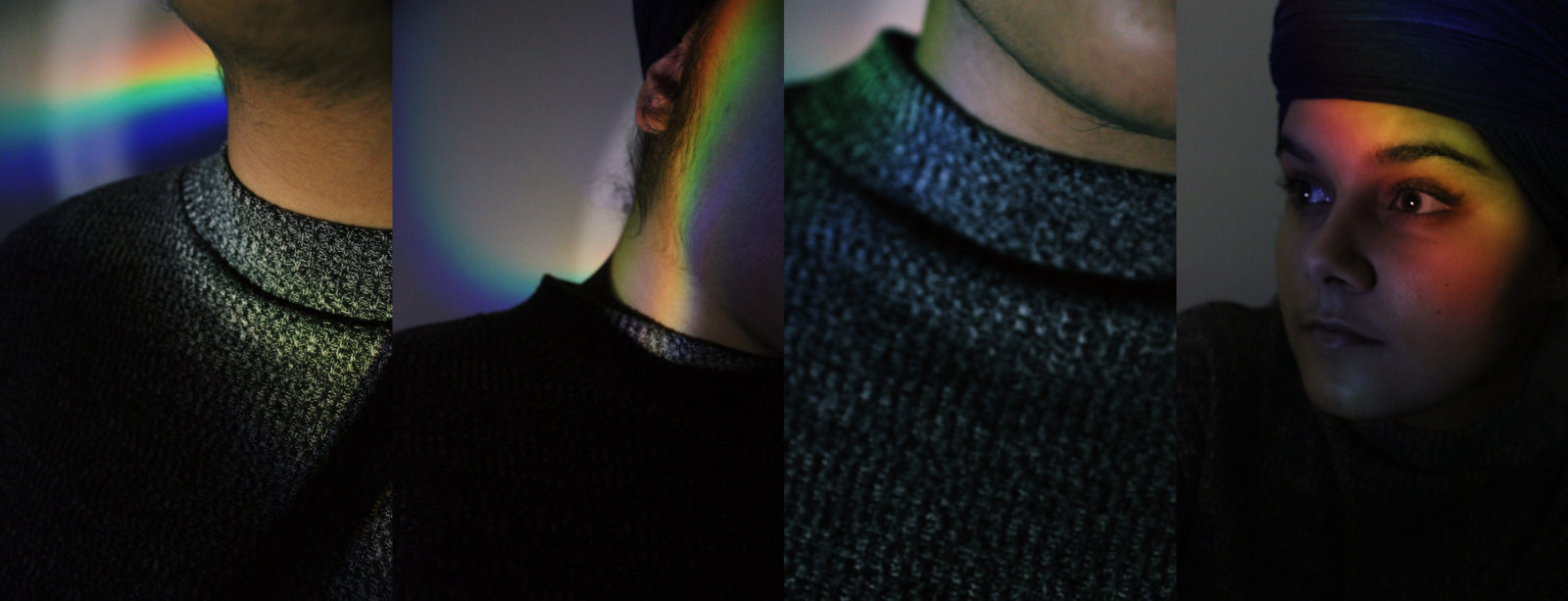By Kanwalroop Kaur Singh
I never thought a dance video should ruin me. But it almost did.
A few months ago, I did a giddha dance challenge on Instagram—expecting some views, and perhaps a few more followers. Like always, I figured the public would watch disinterestedly, forget quickly, and move on to the next social media trend.
What I didn’t expect was that this video would open the floodgates of hate and leave me dead-eyed and scrolling until letters melded together and words stopped making sense. I didn’t expect to wake up to spite, vitriol, and threats of violence and death. I didn’t expect people to put alien face emojis over mine, demand me to delete the video, leave me hate-filled voice messages, and compare me to the anti-Sikh genocidal instigator, Kangana Ranaut. I didn’t expect that instead of commenting on my graceful giddha moves, hundreds of cis men, and some women, would comment on me.
But I should have expected this. I should have realized that I’ve never actually seen a public video on social media of a dancing womxn in a dastaar. I came to the slow realization that as a Sikh womxn who ties a turban, I unwittingly showed many people in the world something they never wanted to see me doing—being complicated, being myself, being free.
ਜਿਉ ਨਾਨਕ ਆਪਿ ਨਚਾਇਦਾ ਤਿਵ ਹੀ ਕੋ ਨਚਾ ॥੨੨॥੧॥ ਸੁਧੁ ॥
jiau naanak aap nachaidhaa tiv hee ko nachaa ||22||1|| sudh ||
Nanak, I dance, as I am made to dance, by the Divine.
Revealed to Guru Amar Das Sahib Ji, Ang 1094
Studies conducted in the United States have shown that womxn and queer people experience disproportionately more sexual harassment and online harassment than cis-gendered men. A third of womxn under 35 (33%) report experiencing sexual harassment online, compared with 11% of cis-men under 35. In 2020, the nonprofit organization, Plan International, conducted over 14000 surveys of young womxn across the world. More than half of the young womxn surveyed had been harassed and abused online. As a result of this online harassment and abuse, one in four felt physically unsafe. Studies have shown that online harassment and abuse can have long-term harmful mental health consequences, including depression, anxiety, suicidal ideation, and panic attacks.
Recently, Punjabi singer, Simiran Kaur Dhadli, released a song called “Lahu Di Awaaz”—addressing what Dhadli perceived to be “shameful” behavior by Punjabi womxn online. The video for Dhadli’s song depicts “revealing” photos of Punjabi womxn, without acknowledging that these photos may have been shared without consent, or that womxn may have been forced into making such content due to poverty, sexual harassment, intimidation, abuse, or other factors. Furthermore, the song ignores the torrents of sexual harassment and abuse womxn experience on the internet, including nonconsensual porn and deepfakes. In 2016, a 21-year old womxn in India committed suicide after a deepfake image of her stitched onto a nude body was posted on Facebook. In her song, Dhadli bullies womxn herself—telling womxn to drown themselves for showing their bodies online. The video crossed 2 million views before it was taken offline due to a copyright claim. While online harassment may not be faced by every Kaur or queer Sikh, it is faced by enough people across the world and in the Sikh community, that it can no longer be ignored.
After the harassment I experienced, I wondered, is there no room in Sikhi for people like me? Must I be either a kachera-wearing, nitnem-doing, dastaar-tying womxn who never dances—or the opposite, a kes-cutting, English-speaking, crop-top wearing womxn who dances all the time? What if I want to be some of both? What if I want to cut my hair but also fight for Khalistan? What if I want to wear a crop top and a kirpan? What if I want to tie a turban and do a dance? Does this make me worthy of abuse? Does it diminish my right to practice Sikhi? I must believe that it does not. Our faith was never meant to be artifice, never meant to be a performance for a black-or-white world.
Let me be clear—I am not amritdhaari, nor do I tie my dastaar everyday. I see myself somewhere low on the spectrum of Sikhi, taking slow and deliberate steps on my journey toward becoming a true Sikh. To me, a true Sikh cannot be someone who looks and acts like a Sikh, yet freely abuses, harasses, and violates those with less power and acceptance in society. And a true Sikh is certainly not someone who conforms to antiquated gendered notions of propriety and performance.
To me, a true Sikh must be committed to a decolonial engagement with Sikhi, to the preservation of a people’s Sikh history, and a Sikh practice rooted in anti-oppression. A true Sikh must be committed to Gurbani, to a belief in the Sacred and Divine (waheguru, rabb). Among other things, a truly true Sikh must be committed to a vision of Sikhi that is free from: discrimination, homophobia, transphobia, casteism, patriarchal violence, sexual violence, and the gender binary.
But one thing that should never define a true Sikh is whether they dance.
ਜਬ ਨਾਚੀ ਤਬ ਘੂਘਟੁ ਕੈਸਾ ਮਟੁਕੀ ਫੋੜਿ ਨਿਰਾਰੀ ॥
jab naachee tab ghooghaT kaisaa maTukee foR niraaree ||
When she dance, why does she need the veil? Break the pot and be free.
ਨਾਨਕ ਆਪੈ ਆਪੁ ਪਛਾਣੈ ਗੁਰਮੁਖਿ ਤਤੁ ਬੀਚਾਰੀ ॥੪॥੪॥
naanak aapai aap pachhaanai gurmukh tat beechaaree ||4||4||
Nanak, recognize yourself, a Gurmukh must contemplate the Truth.
Revealed to Guru Nanak Sahib Ji, Ang 1112
Yet, gender performance defines how we perceive Sikhi in ways that it should not. For example, for turban-wearing cis men, turbans are deemed sacred. Many can dance, drink alcohol, do drugs, show off their bodies, have sex, cheat on their partners, engage in sexual abuse, domestic abuse, rape, or murder— often without being shamed by hordes of other cis-men, without being told to take their turbans off, without being told they are unworthy of their turbans (in most cases that I’ve observed).
Yet, based on my experince and discussions, for turban-wearing women, or queer, trans, and gender fluid Sikhs, turbans are viewed as “accessories”. If we tie our turbans while wearing makeup, crop tops, or dancing, many tell us to take them off. These people often tell us our turbans are not a fashion statement. But why would they be? Why are our turbans gendered as superficial, fashionable, or decorative just because we wear makeup or dance—while men’s turbans are perpetual symbols of honor, pride, their dedication to their faith? We are harshly policed for how we look, how we dress, how we act, while we practice our Sikhi. Yet, regardless of what harm or violence they inflict, cis men do not seem to be .
Policing, violating, maiming, and dismembering female, femme, feminine, and genderqueer bodies is sadly a time-honored tradition in Punjabi culture. A declining sex ratio, female feticide, sex-selective abortion, honor killings—all this has made it a miracle that those of us who were born as Punjabi Sikh womxn are alive today. In Desi culture generally, honor has historically resided in womxn’s bodies—womxn, not men, are shamed, abused, and killed when their sexuality and behavior are deemed to be outside of patriarchal control. In 2016, Qandeel Baloch, a Pakistani influencer, was killed by her brother for the content she posted online—primarily selfies, flirtatious poses, and videos.
Cis-het womxn are not the only targets of hetero-patriarchy. People who are born as cis-men, but stop identifying as such, instead presenting or identifying as feminine, femmes, queer, or genderqueer are also deemed “dishonorable” for not conforming to patriarchal control. A 2019 survey of 900 college students across many countries revealed people in India and Pakistan were the most likely to believe that being LGBTQ brought dishonor to one’s family and that the abuse of LGBTQ individuals was justified.
Sometimes cis-womxn can be the fiercest enforcers of heteropatriarchy. Cis-womxn also participate in controlling, monitoring, and punishing people who do not conform to gender expectations or patriarchal control—the singer Simiran Kaur Dhadli’s recent song is an example. Honor discourse may have shifted from the sitting room to social media, but the content of it has not changed—in fact, those at the behest of the patriarchy have even more access, even more technology, even more reach, to engage in harassment and violence in the name of “honor.”
Time and time again, I see Sikh womxn, genderqueer Sikhs, and trans Sikhs, who dare to post photos and videos of themselves working out, wearing makeup, wearing dresses, flirting, dancing, and generally living their best lives. They are often forced to contend with toxic people who bully, demean, and shame them. Some continue in the face of this abuse and harassment, and others don’t. Sadly, online harassment has become a rite of passage for so many Sikhs who present as femmes, or as genderqueer, or as trans. The world tells us to either deal with it or disappear.
If we try to deal with it, we are triggered by threatening posts that elicit traumatic memories and feelings from past experiences with homophobia, transphobia, sexual harassment, and violence. If we disappear from social media, we are denied access to societal acceptance, potential income streams, and much needed community. The only other option is to continue to express ourselves, while distancing ourselves from Sikhi entirely. Yet, not only does this rob us of our right to practice our faith freely and to access community, it forces us to locate ourselves a binary where Sikhs are either never “religious”, or too “religious.” But people are too complicated, contradictory, and beautifully layered for a binary world.
It seems to me that many cis Sikh men are allowed to live in that expansive and free space where they can look, act and be however “religious” they wish to be, without fear of being judged or policed. But many Sikh womxn or genderqueer/trans Sikhs are constrained by narrow definitions of Sikhi. Either tie your keski and pray—or cut your hair and party. If you’re a Sikh womxn or a genderqueer/trans Sikh—never tie your keski and party. What I hear from our community is that if we want to perform as genderqueer or as femmes, while also appearing as Sikhs, we must pay a price. This is maddening if you are the type of person who believes Sikhi was always meant to exist beyond gender. If Gurbani does not dwell on gender, and on policing its borders—why do we? In our quest to enforce the borders of gender, we have become singularly focused on appearances. The visual politics of appearing as a Sikh appears to be more important than your actual politics as a Sikh.
ਅੰਦਰਹੁ ਝੂਠੇ ਪੈਜ ਬਾਹਰਿ ਦੁਨੀਆ ਅੰਦਰਿ ਫੈਲੁ ॥
a(n)dharahu jhooThe paij baahar dhuneeaa a(n)dhar fail ||
Those who are false within, and honorable on the outside, are very common in this world.
In truth, my dance video is no longer on Instagram. I ended up deleting the page I posted it on due to the general toxicity of social media. But I would be lying to you if I said I only deleted it for that reason. Somewhere deep inside, I did fear that I would be attacked one day by someone who decided that I had insulted Sikhi with my dancing. Despite my belief that I am a free and independent womxn who need not bow down to patriarchy, I know that I still live in a world where my reputation as a Sikh womxn matters. And this reputation is determined by people who still largely believe in heteropatriarchal notions of gender, people who have allowed gender to despotically rule their lives.
I know that almost none of my harassers, most of whom are in Punjab, will be able to read or understand this. This is not their fault. However, I do not write this for them. I write this for the all the Kaurs and gender queer Sikhs out there who want to dance. May you and I continue to disrupt the gender binary with our feminist and queer joy. Rather than distancing ourselves from Sikhi, may we begin to define it.
Resources for people targeted by online harassment and abuse:
- Online Harassment Field Manual
- Mental Health Resources
- Fighting Cyberstalking Resources
- Dealing with Nonconsensual Pornography
- Understanding Online Challenges Faced by South Asian Womxn
Resource for people trying to be better allies to queer and trans Sikhs and Sikh womxn:
- Am I Cyberbullying?
- Masculinity, Male Privilege, and Consent Toolkit
- Male Privilege and Challenging Sexism for Men of Conscience
- South Asian Network to Address Masculinities (SANAM)
- Digital Activism for Equitable, Compassionate, and Non-Violent Ways of Being Men During COVID-19
- Internalized Homophobia
- Tips for Allies of Transgender People
- Amplify Your Voice Resource Kit
About Kanwalroop Kaur Singh
Kanwalroop Kaur Singh is a writer and civil rights attorney who lives on Ohlone land in California. You can reach her on her Instagram page, @kanwalroop.kaur.





No Comments